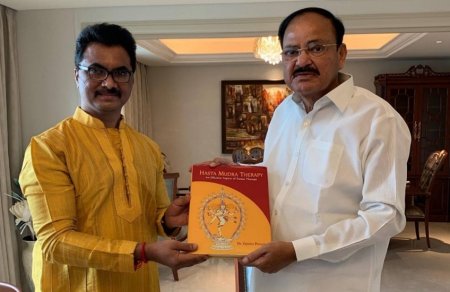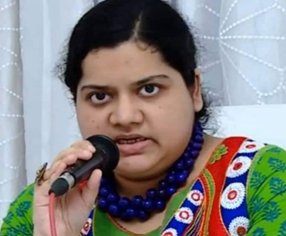
|   |

|   |
Hasta Mudra Therapy by Dr. Vijayapal Pathloth - B. Naveena e-mail: naveena_b_2002@yahoo.co.in March 5, 2022  "Na tajj˝ānaṃ na tacchilpaṃ na sā vidyā na sā kalā। Nāsau yogo na tatkarma nāṭye'smin yanna dṛśyate" This oft-quoted verse perhaps best sums up the multipronged optic that dance deserves to be looked at. The book under review is the published Doctoral thesis of Dr. Vijayapal Pathloth, a dancer from Hyderabad who performs Kuchipudi, Perini Natyam and Andhranatyam. Vijayapal had obtained Ph.D. from the Hyderabad Central University and is currently a Faculty at the Potti Sriramulu Telugu University. This book was released recently by the Hon'ble Vice-President of India, Venkaiah Naidu. The book throws fresh perspective on hand gestures and their manifold manifestations in Natya, Yoga, Ayurveda, spirituality, religious rituals et al, with special emphasis on their role in alternative therapy. The author has reportedly experimented its efficacy on adults and children belonging to the Hyderabad-based Sanskriti school for the mentally and physically- challenged. The book opens with a brief overview of dance per se, also describing its connection with other disciplines. The first chapter deals with the word 'dance therapy', its origin from the Greek word, 'therapeia', different types of therapy, instances where it has helped dancers face personal crises, personal losses and physical ailments and also its spread across the world. The author lists several pioneers of modern dance and practitioners of psychiatry who have taken Dance Movement Therapy to wider horizons. He also enumerates the different Associations, Universities and other global bodies which enlist members and practitioners, while also throwing light on research in Dance Therapy. The author also lists various Indian treatises on dance and this compilation is quite exhaustive. The book then deals with hasta mudras in daily life, as a layman may perceive them. A comparative list of nrttahastas as enumerated in various treatises is given, apart from providing valuable nuggets of information. For eg., the 'Balarama Bharatam', a dance treatise from Kerala categorises hastas according to the gender. However, the Sangita Muktavali by Devanacharya, also a major work on dance, is conspicuous by its absence. The book then deals with the nexus between hasta mudras and Yoga. Interestingly, Patanjali, the proponent of Yoga, never mentioned anything about mudras in his magnum opus, 'Yogasūtram', which is more concerned with the cessation of mental activities.(Yogaś-citta-vṛtti-nirodhah, states Patanjali as the first tenet). But later advocates of Yoga have incorporated mudras as an important addendum. The author quotes aptly from ancient treatises like the Gheranda Samhita and Mudra Vij˝anam. The next portion of the book deals with the usages of mudras and the various benefits that accrue from such usage, in the sphere of Ayurveda. The author goes to the realm of religion, depicting through beautiful photographs, the various mudras held by the pantheon of Hindu deities. Mudras in tantric worship, the relevant naamas in the Lalitha Sahasranama are neatly correlated by the author. He has taken pains to quote from rare works like the Subalopanishad and Kshurikopanishad. Certain rituals which have now been forgotten also find mention and these include Balivaisva and Pranagnihotra Yajna, which extensively use mudras. The ensuing portions deal with mudras as seen in Jainism and Buddhism. The author makes interesting observations of how the Abhaya mudra and Varada mudra combine are seen in rituals in Japan in the form of Segan Semui and Yogen Semui. In the earlier sections, the author has also mentioned the mudras used by the Babylonian God, Damuzi, while descending into the underworld. The author then elaborates on the role of the hand in acupuncture, the physiology of the palm and the interconnection between various nerve endings. This technical section includes several illustrations from medical journals and is painstakingly compiled. The author makes a case for Hasta Mudra Therapy as a valuable addition to pharmacokinetics, which he defines as a combination of medicines and alternative movement therapy. The connection of each finger with the panchabhutas is a repetition from the earlier sections and is therefore redundant here. The author delineates the experiment he carried out for 2 academic years, to bring about improvement in adults and children who are suffering from various common ailments and mental disabilities, respectively. Different activities and games for children were designed so as to make them use hastas, and good development in the wards was reportedly noted by the teachers on a periodic basis. Even adults were asked to hold specific mudras for a specific time, so as to get rid of common ailments troubling them. Feedback was recorded on a standardized questionnaire. By the author's own admission, "The Hasta Mudra Therapy is (sic) proved to be a good way to boost the energy levels and enhance the joy of living in case of differently-abled children. Though the study is promising, the number of children is exceedingly small. Hence, sweeping conclusions cannot be drawn in this case.To substantiate the therapeutic effects of Hasta Mudras in these special children, much deeper study had (sic) to be undertaken, and a separate therapeutic analysis must be done." The author also suggests that similar study may be undertaken to admeasure the effectiveness of Pada bhedas as a form of therapy. Though it draws from several disciplines, the book is for the major part, a quick-read, packing-in interesting nuggets of information at many places. However, spelling, grammar, punctuation, and authenticity in quoting verses, are some of the areas which cry for attention. Only when these are dealt with the respect they deserve, will the book find favour with cognoscenti. Sample of these errors: Of the nearly 30 Samskrtam verses quoted in the book, NOT ONE has been quoted accurately. The spellings of words are mostly wrong, as also their splittings. Some words are missing in a verse or two. Also, one does not comprehend why the book does not conform to the transliteration of Samskrtam letters as laid-down by the International Congress of Orientalists in Athens in 1912, which is what is followed all over the world without exception. Some words are spelt like the way Telugus pronounce them (Shodashopacharamulu), while some words are spelt the way they are pronounced in Hindi (Geet). Their original Samskrtam spelling is what can be construed as authentic and worthy of emulation. There are even certain places where the opposite meaning has been conveyed due to wrong splitting. (Pg. 56 "kanthae naalambayaeth geetam," which translates to "never sing with the throat! "Kanṭhena ālambayet gītam" would be the correct splitting. Factual errors have escaped the lackadaisical editor's eye. In Pg 41, the sentence goes thus: "ending of Dwaapara and beginning of Tretayuga". Obviously, it is Kaliyuga that should have been mentioned in place of Treta. Similarly, in Pg .70, "Samyuta hastas and Samyuta hastas" should have read as Samyuta and Asamyuta. Pg 101 states "legs going to sleep!" This is better interpreted as "numbness of legs". In this entire section relating to Ayurveda, the ailments are listed under the heading, "Benefits"! Pg 65: "Henna gives adoration" should read as "Henna serves as an adornment." Pg 143 mentions: "Hasta Mudras generally means an "Awakened One"! This should of course, read as: "Buddha means an Awakened One", since the section deals with mudras in Buddhism. Errors in punctuations too, make for strain in reading. For eg., in pg. 24, the quotation by Anita Ratnam actually continues even after the quotation marks end. The author keeps referring to Bhaarat in parentheses, immediately following the word India, in every page, several times. What is the idea behind this usage? Either of the words will do. Similar is the usage of "Indian Classical Dance (Bharateeya Sastreeya Nritya)". One can only fervently hope that the book rids itself of all these faults in its revised edition, thereby proving to be a worthy addition to one's bookshelf.  B. Naveena holds an M.B.A. in Human Resources and an M.A. in Samskrtam. She loves to speak and write on language and fine arts. She is a multilinguist, writer, translator, singer and quizzer. Post your comment Please provide your name and email id when you use the Anonymous / blog profile to post a comment. All appropriate comments posted in the blog will also be featured in the site. |